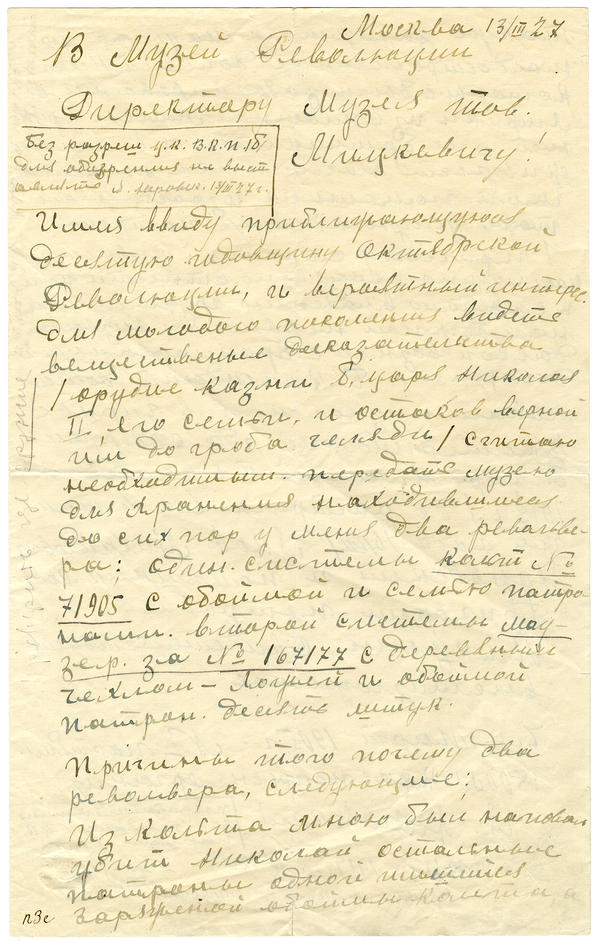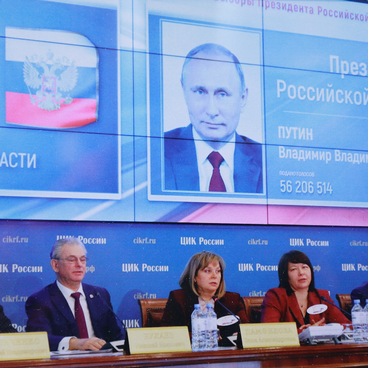The exhibition features a letter from the superintendent of the Ipatiev House Yakov Yurovsky to Director of the USSR Museum of the Revolution Sergei Mickiewicz. The letter describes the circumstances of the execution of Emperor Nicholas II and his family.
After the February 1917 Revolution, the last Russian Emperor abdicated from the Russian throne. At first he was placed under house arrest in Tsarskoye Selo. In August, the Provisional Government had Nicolas and his family moved to Tobolsk and later to Yekaterinburg in 1918.
Nicholas II, Aleksandra Fyodorovna, their children Alexei, Olga, Maria, Anastasia and Tatiana, as well as the doctor, the maid, the cook and the valet of the family were shot in the house of engineer Ipatiev on the night of July 16 to 17, 1918. Revolutionary Yakov Yurovsky, the superintendant of the house, led the execution.
By the 10th anniversary of the October 1917 Revolution, Yurovsky handed over the revolvers that killed the royal family to the USSR Museum of the Revolution, accompanying them with a letter. The weapons were confiscated by the NKVD (secret police) officers, and the museum was, for a long time, prohibited to display the letter.
The letter reads: ‘Moscow 13/III 27. To the Museum of the Revolution. To Director of the Museum Comrade Mickiewicz. Not to be exhibited without permission of the Central Committee of the All-Russia Communist Party (Bolshevik). Ya. Yurovsky. 13/III 27.In view of the approaching tenth anniversary of the October 1917 Revolution and a potential interest of the young generation in seeing the physical evidence (the instrument of execution of the former Tsar Nicholas II, his family, and those servants who remained faithful to them to the last), I consider it necessary to hand over to the Museum for storage two revolvers, one Colt 71905 with a loading clip and seven cartridges, and Mauser rifle ¹ 167177 with a wooden casing - a stock and a cartridge. Ten pieces. The reasons why there are two revolvers are as follows: I shot Nicholas dead by the Colt, the rest of the cartridges of the Colt loaded magazine, as well as the loaded Mauser went to finish off Nicholas’s daughters, who were armored in the bodices with a solid mass of huge diamonds sewn into them. And the strange survivorship of the heir, on whom my assistant also spent a whole round of ammunition (the reason for the strange survivorship should probably be attributed to either his poor weapons handling or the inevitable nervousness caused by a long hustle with the armored daughters). Former superintendant of the special-purpose house in the city of Yekaterinburg, where the former Tsar Nicholas II and his family were kept in 1918. (Prior to his execution in the same year on 16/VII). Yakov Michailovich Yurovsky and his assistant, commander Grigory Petrovich Nikulin.’
After the February 1917 Revolution, the last Russian Emperor abdicated from the Russian throne. At first he was placed under house arrest in Tsarskoye Selo. In August, the Provisional Government had Nicolas and his family moved to Tobolsk and later to Yekaterinburg in 1918.
Nicholas II, Aleksandra Fyodorovna, their children Alexei, Olga, Maria, Anastasia and Tatiana, as well as the doctor, the maid, the cook and the valet of the family were shot in the house of engineer Ipatiev on the night of July 16 to 17, 1918. Revolutionary Yakov Yurovsky, the superintendant of the house, led the execution.
By the 10th anniversary of the October 1917 Revolution, Yurovsky handed over the revolvers that killed the royal family to the USSR Museum of the Revolution, accompanying them with a letter. The weapons were confiscated by the NKVD (secret police) officers, and the museum was, for a long time, prohibited to display the letter.
The letter reads: ‘Moscow 13/III 27. To the Museum of the Revolution. To Director of the Museum Comrade Mickiewicz. Not to be exhibited without permission of the Central Committee of the All-Russia Communist Party (Bolshevik). Ya. Yurovsky. 13/III 27.In view of the approaching tenth anniversary of the October 1917 Revolution and a potential interest of the young generation in seeing the physical evidence (the instrument of execution of the former Tsar Nicholas II, his family, and those servants who remained faithful to them to the last), I consider it necessary to hand over to the Museum for storage two revolvers, one Colt 71905 with a loading clip and seven cartridges, and Mauser rifle ¹ 167177 with a wooden casing - a stock and a cartridge. Ten pieces. The reasons why there are two revolvers are as follows: I shot Nicholas dead by the Colt, the rest of the cartridges of the Colt loaded magazine, as well as the loaded Mauser went to finish off Nicholas’s daughters, who were armored in the bodices with a solid mass of huge diamonds sewn into them. And the strange survivorship of the heir, on whom my assistant also spent a whole round of ammunition (the reason for the strange survivorship should probably be attributed to either his poor weapons handling or the inevitable nervousness caused by a long hustle with the armored daughters). Former superintendant of the special-purpose house in the city of Yekaterinburg, where the former Tsar Nicholas II and his family were kept in 1918. (Prior to his execution in the same year on 16/VII). Yakov Michailovich Yurovsky and his assistant, commander Grigory Petrovich Nikulin.’



